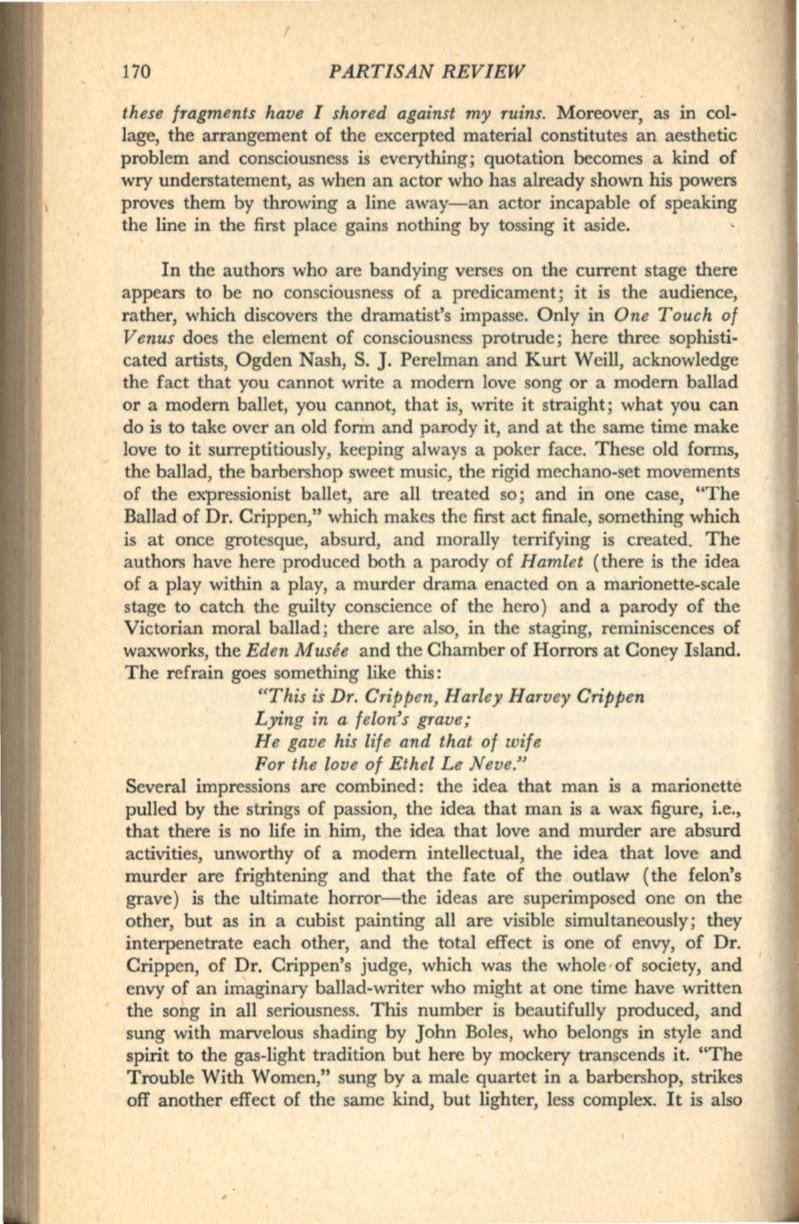
170
PARTISAN REVIEW
these fragments have I shored against my ruins.
Moreover, as in col–
lage, the arrangement of the excerpted material constitutes an aesthetic
problem and consciousness is everything; quotation becomes a kind of
wry understatement, as when an actor who has already shown his powers
proves them by throwing a line away-an actor incapable of speaking
the line in the first place gains nothing by tossing it aside.
In the authors who are bandying verses on the current stage there
appears to be no consciousness of a predicament; it is the audience,
rather, which discovers the dramatist's impasse. Only in
One Touch of
Venus
does the element of consciousness protrude; here three sophisti–
cated artists, Ogden Nash, S. J. Perelman and Kurt Weill, acknowledge
the fact that you cannot write a modern love song or a modern ballad
or a modern ballet, you cannot, that is, write it straight; what you can
do is to take over an old form and parody it, and at the same time make
love to it surreptitiously, keeping always a poker face. These old forms,
the ballad, the barbershop sweet music, the rigid mechano-set movements
of the expressionist ballet, are all treated so; and in one case, "The
Ballad of Dr. Crippen," which makes the first act finale, something which
is at once grotesque, absurd, and morally terrifying is created_ The
authors have here produced both a parody of
Hamlet
(there is the idea
of a play within a play, a murder drama enacted on a marionette-scale
stage to catch the guilty conscience of the hero) and a parody of the
Victorian moral ballad; there are also, in the staging, reminiscences of
waxworks, the
Eden Musee
and the Chamber of Horrors at Coney Island.
The refrain goes something like this:
"This is Dr. Crippen, Harley Harvey Crippen
Lying in a felon's grave;
He gave his life and that of wife
For the love of Ethel Le Neve."
Several impressions are combined: the idea that man is a marionette
pulled by the strings of passion, the idea that man is a wax figure, i.e.,
that there is no life in
him,
the idea that love and murder are absurd
activities, unworthy of a modern intellectual, the idea that love and
murder are frightening and that the fate of the outlaw (the felon's
grave)
is
the ultimate horror-the ideas are superimposed one on the
other, but as in a cubist painting all are visible simultaneously; they
interpenetrate each other, and the total effect is one of envy, of Dr.
Crippen, of Dr. Crippen's judge, which was the whole · of society, and
envy of an imaginary ballad-writer who might at one time have written
the song in all seriousness. This number is beautifully produced, and
sung with marvelous shading by John Boles, who belongs in style and
spirit to the gas-light tradition but here by mockery transcends it. "The
Trouble With Women," sung by a male quartet in a barbershop, strikes
off another effect of the same kind, but lighter, less complex. It is also


